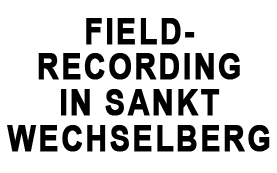

FIELDRECORDING IN SANKT WECHSELBERG (2001/~9 min.)
Actors:
Robert Stachel, Frank Apunkt Schneider
(Transcription of English subtitles)
Around one and a half years ago, the American experimental musician Jerry Zachary Adamski conceived one of the most unusual and exciting projects in recent music history at the University of Cleveland’s Ronald K. Burgmeister Institute for Cybernetic Composition.
Adamski, who took his doctorate in 1996 at Lisbon University with a dissertation on John Erkenschwind’s microtonal composition cycle Aleatorics, Algorhythms & Prisms of Sound, has for years been considered to be one of the most important and advanced exponents of the North American electro-acoustic scene.
His collaborations with free jazz groups like Work in Progress, Gunther Hempelfurther’s Indeterminancy, Relais or Jürgen Engelhoff‘s Werkbund Freier Posaunisten, Donaueschingen as well as his Interferences & Interactions with the composition student György Szcorloz have brought him the reputation of an all-rounder in the fields of serious modern music and free improvisation.
A potential way out of the much-discussed crisis of “free music” was also charted by his work with the French philosopher Lucienne Kléber in which the latter played the nei, a traditional Persian reed flute. This cooperative effort was documented by the Stockholm label Evolution Twist on two CD releases: Political Power Grows from the Barrel of a Shaft, a 1993 composition combining archive recordings of the Paris street riots of May 1968 with a score for nei, prepared piano, radio, airbag and a Hip Hop DJ, and the “discourse-critical found sound de-installation” Gilles Deleuze fait la carte au toilet avec Michel Foucault.
His contributions to Alonso Jorgo’s project series The Sounds of Science – including the sound installation Morphogenetic Grooves for a New World Order, which was presented in 1997 in the aula of the Paris Sorbonne, and the serial two-tone cycle Six-dimensional Field Recordings Dot Rewind, which had its simultaneous world-premiere in subway stations in Tokyo, Montreal, Stuttgart, London and Austin, Texas on 2 November 1999 – are impressive and outstanding achievements in which the fields “Sound Design” and “Science Performance” overlap.
A similar direction is displayed by his most recent project, entitled Microspheric Jam on a Macrospheric Body: Globalization Cluster for One Weltgeist, 7 Different Spaces and One Contact Microphone. Here Adamski takes up the theory of the subatomic multiacrum, which recently was proven experimentally by Kenneth Eldrige and Iljenka Mashakoviev, making it the basis of a deterritorial artification, i.e. a “creative effort transgressing from the semantic frame of reference of science into the semiotic field-macro of art.”
The underlying theory of polyradial or dislocutionary moves and countermoves could, in the opinion of several experimental physicists, form the point of departure for a unified field theory. The basis for this hypothesis are the so-called mytrons, a coaxial matrix of atomic particles whose assumed oscillitory invergence of minus 17 has been confirmed in a number of laboratory experiments.
Jerry Zachary Adamski has transposed this matrix onto the magnetic field line systogram of the earth developed by Myra Hodginson and Julius Sundbrunnen, whereby seven “geosonar bijectives” were determined, i.e. points of interface between earth-immanent micro- and earth-constitutive macrostructure. At these geographical points Adamski will produce specific “sound markings” on location.
The material for this endeavor is made up of various stones found at the sites as well as other found sound accumulators. Through the “sound-generating querying of their materiality, they will be reformatted into sound design in the recording process,” states Adamski. Later this material will undergo further manipulation at the University of Cleveland’s Research Pool Lab studio.
The layering of the “sound traces” collected at the various locations around the globe, which derive from both geological and human history, is intended to produce a global vibration. Adamski would like to make this vibration audible at the Berner Festival für neue Musik in 2002, which will be held under the motto The Sound of Globalization.
In the international field recording scene, Adamski’s protracted involvement with the medium “stone” has led to his being humorously dubbed the “Andrew Lloyd Webber of Stones,” as he himself reports with a smirk.
Here we see him in St. Wechselberg, one of the Austrian province of Burgenland’s smallest communities. The third station of his globe-spanning sound excursion is located here, right next to the pilgrimage chapel of devotion to St. Meinrade.
Currently Adamksi is capturing both the ephemeral sounds of pebbles and of their acoustic interaction with the exterior wall of the aforementioned chapel. His journey into the Sound-Self of our earth has led him from a point in the arctic approximately 200 km southeast of the North Pole via Newfoundland to St. Wechselberg.
The next station is located in the middle of the Atlantic on a conceptual line drawn between Nouakchott in Mauritania and the island group New Lorraine in the vicinity of the fortieth parallel.
There, with the help of the newest submarine recovery technology, Adamski will raise stones to the surface from an estimated ocean depth of 400 meters and bring them into sonic resonance. This costly endeavor is to be supported by funds from the Jennifer Manilow Foundation for the Promotion of New Music. The expenses incurred by a specially modified deep-sea crane and its crew are expected to amount to around 7,000 dollars per day.
The next geosonar bijective is also under water, this time in the Indian Ocean east of the Chagos Archipelago at a depth of 150 meters.
The concluding stations of this interesting study “cartographizing the psychogeological structure of the world sound body,” as Adamski writes in the manifesto published in conjunction with the project entitled The Eternal Frontier Within, are located in the Central Australian Desert and in the Antarctic 42 km northwest of the South Pole.
In the summer of 2001 Adamski is scheduled to return to Cleveland, where he will evaluate the material assembled in the course of his odyssey.
Most of all, the attention to detail at the heart of Adamski’s working process, his willingness to open himself to the material, demands a great deal of patience. Entering into an interactive meditative relationship with stones, the representatives of a geomorphic sound substrate, is an endeavor that initially requires a process of inner cleansing from the everyday sound toxins of a world that has been acoustically colonized to the last of its frontiers, Adamski reminds correspondents at a press conference in the Neue Bürgerzentrum in St. Wechselberg. Contemplative immersion in the selected object is the prerequisite for finding the inner sound of the Thing, and this is the central aim of his work in field recording.
Thus Adamski will be remaining in St. Wechselberg for several more weeks, where he will continue to survey sonic reality in the vicinity of the secluded chapel.